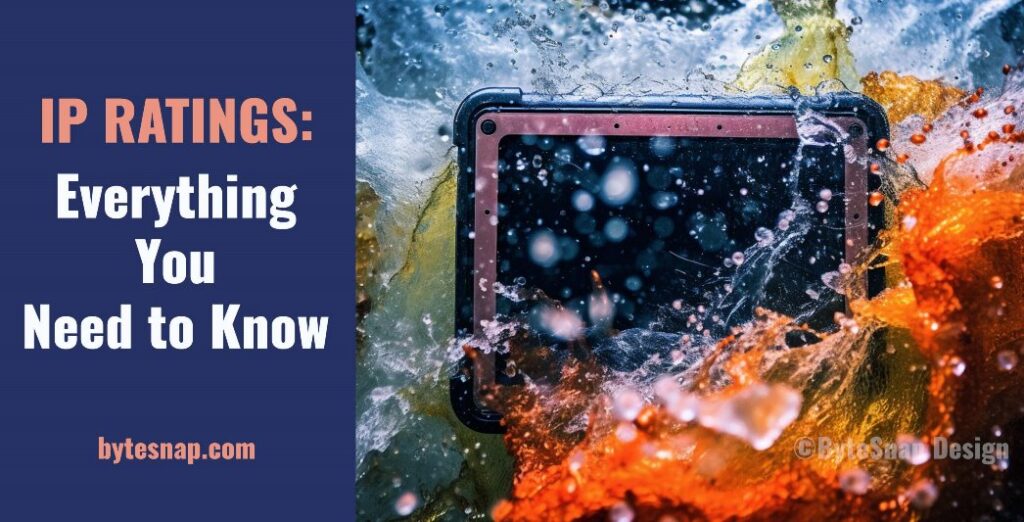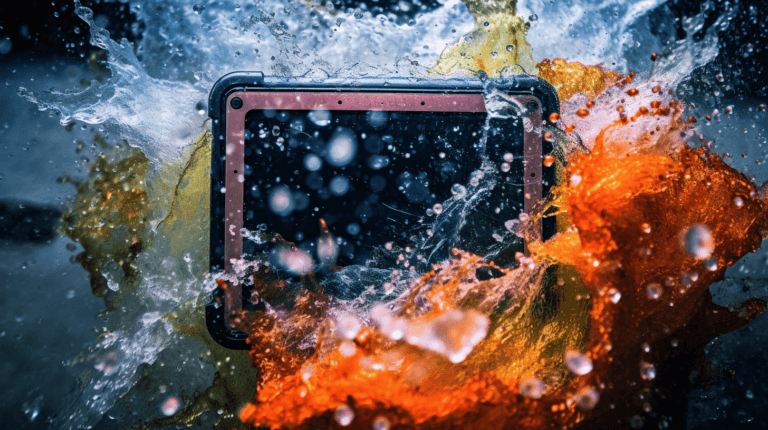IP Ratings: Understanding the Basics
When it comes to electronic devices, their protection against dust and water intrusion is critical.
The Ingress Protection (IP) rating protocol is a universal standard used to rank the level of protection an electronic device has against the intrusion of foreign particles such as dust and water.
As we’re often asked about IP ratings at ByteSnap Design, we’ve created this handy guide to give you an overview of the standard.

At its core, the IP rating system is designed to offer a reliable way of understanding the level of protection offered by a device.
The IP rating is a two-digit number; the first shows the degree of protection against solid objects, and the second relates to protection against liquids.
Contents
The First Digit: Protection Against Solid Objects
The first digit refers to the protection level against the intrusion of solid objects. It ranges from 0-6, and each level indicates a specific level of protection:
0 – No protection against solid objects
1 – Protection against solid objects larger than 50mm
2 – Protection against solid objects larger than 12.5mm
3 – Protection against solid objects larger than 2.5mm
4 – Protection against solid objects larger than 1mm
5 – Dust-protected, but some dust may still get inside
6 – Dust-tight, no dust can get inside
The Second Digit: Protection Against Liquids
The second digit indicates the level of protection against liquids. It ranges from 0-8.
Again, each level indicates a specific level of protection:
0 – No protection against liquids
1 – Protection against vertically falling drops of water
2 – Protection against vertically falling drops of water when the enclosure is tilted up to 15 degrees
3 – Protection against spraying water at an angle of up to 60 degrees from vertical
4 – Protection against splashing water from any angle
5 – Protection against low-pressure water jets from any direction
6 – Protection against high-pressure water jets from any direction
7 – Protection against the effects of immersion in water for up to 30 minutes at a depth of up to 1 metre
8 – Protection against the effects of continuous immersion in water under conditions specified by the manufacturer

The Importance of IP Ratings
Without a standardised rating system, manufacturers may find it challenging to communicate the level of protection offered by their products, leading to confusion and a mismatch of expectations.
The IP system guarantees that electronic devices can function as intended in particular environments.
In addition, manufacturers can design products that meet specific environmental needs, thus allowing consumers to make informed buying choices.
Further advice
Getting it wrong on IP ratings is a costly mistake with potentially devastating consequences.
Get it right first time by getting the best advice and information to ensure you have the correct rating for your product.
One option is to engage with an experienced IP rating consultant who can provide specialized expertise and guidance on the requirements and testing procedures for your product development.
At ByteSnap, we work with experts in IP ratings – and they’re invaluable to our product development process.
You can also refer to industry standards organisations, such as:
- The International Electrotechnical Commission (IEC), which provides technical specifications for a wide range of electronic devices and can offer guidance on the IP rating standards
- The American National Standards Institute (ANSI) and the National Electrical Manufacturers Association (NEMA) also offer guidance on device protection standards in the United States.
Also, look out for online resources – such as technical forums, discussion groups, and blogs – to connect with experts in the field.
The IP rating system ensures that electronic devices can function optimally in their intended environments and helps manufacturers to design products that meet specific environmental needs.
Without such a system, it would be challenging for manufacturers to communicate the level of protection offered by their products, leading to confusion and a mismatch of expectations.
Seek professional advice from a specialist to make certain you have the right rating for your device.
Don't leave the protection of your electronic devices to chance
We can help you navigate the complex world of IP ratingsand deliver the best possible solution for your development project >>
Book a callConclusion
IP ratings are vital to electronic device design, and it is essential to understand the protection levels provided by the system.
We hope this guide has provided you with information to help you make informed purchasing decisions and ensure that your electronic devices can function at their best in their intended environments.
Are you developing a new electronic product that requires IP-rated elements, and need expert guidance?
At ByteSnap, we offer comprehensive design and engineering services to help you shorten your time-to-market.
Our experienced engineering consultants are experts in the design and development of IP-rated electronic products.
We have extensive experience working with a wide range of devices and can offer specialised expertise in selecting the right IP rating for your project.
Contact us today to schedule a consultation with our engineering consultants – take the first step towards developing a high-quality and reliable electronic product that meets your customers’ needs.
Frequently Asked Questions
Q: What is the IP rating system?
This is a worldwide system used to rank the level of protection that an electronic device has against the intrusion of foreign particles such as dust and water. It features two digits; the first is specific to protection against solid objects, and the second digit indicates the degree of protection against liquids.
Q: How does the IP rating system work?
The higher the number, the greater the level of protection. The first digit of the IP rating - representing level of protection against solid objects - ranges from 0 to 6. The second digit - from 0 to 8, shows the level of protection against liquids.
Q: What does each level of the IP rating system mean?
The first digit ranges from 0-6, where 0 means no protection against solid objects, and 6 means the device is dust-tight, and no dust can get inside.
The second digit ranges from 0-8, where 0 means no protection against liquids, and 8 implies the device is able to withstand the effects of continuous immersion in water under conditions specified by the manufacturer.
Q: Why is the IP rating system important?
The system exists to provide a guarantee that electronic devices will function optimally in their intended environments. It's valuable to manufacturers as it helps them design products for specific environmental requirements, and it also allows consumers to make informed buying decisions.
Q: Can the IP rating system be used for all electronic devices?
Yes - it can be used for all electronic devices, including smartphones, cameras, and smartwatches.
Q: How can I check the IP rating of my electronic device?
The IP rating of an electronic device is typically listed in the device specifications or manual. You can also search online for the device's IP rating using the model number.
Q: Is the IP rating system the only standard for device protection?
No, there are other standards for device protection, such as the National Electrical Manufacturers Association (NEMA) rating system in the United States.
Q: What happens if an electronic device is not rated for the environment it is used in?
If an electronic device is not rated for the environment it is used in, it may malfunction or sustain damage. Therefore, it is important to use electronic devices that are rated for the environment they will be used in.
Q: Can an IP rating be upgraded or changed?
No, it can't be upgraded or changed. It is a fixed rating that indicates the level of protection that the device offers against solid objects and liquids.
Further Reading
- International Electrotechnical Commission (IEC) – https://www.iec.ch/
- American National Standards Institute (ANSI) – https://www.ansi.org/
- National Electrical Manufacturers Association (NEMA) – https://www.nema.org/
- https://www.en.wikipedia.org/wiki/IP_Code
- https://www.batterydesign.net/ip-ratings/

Dunstan is a chartered electronics engineer who has been providing embedded systems design, production and consultancy to businesses around the world for over 30 years.
Dunstan graduated from Cambridge University with a degree in electronics engineering in 1992. After working in the industry for several years, he co-founded multi-award-winning electronics engineering consultancy ByteSnap Design in 2008. He then went on to launch international EV charging design consultancy Versinetic during the 2020 global lockdown.
An experienced conference speaker domestically and internationally, Dunstan covers several areas of electronics product development, including IoT, integrated software design and complex project management.
In his spare time, Dunstan enjoys hiking and astronomy.




